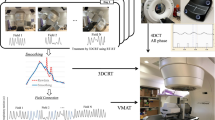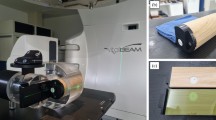Abstract
The aim of the present study was to investigate the effect of tumour motion on various imaging strategies as well as on treatment plan accuracy for lung stereotactic body radiotherapy treatment (SBRT) cases. The ExacTrac gating phantom and paraffin were used to investigate respiratory motion and represent a lung tumour, respectively. Four-dimensional computed tomography (4DCT) imaging was performed, while the phantom was moving sinusoidally with 4 s cycling time with three different amplitudes of 8, 16, and 24 mm. Reconstructions were done with maximum (MIP) and average intensity projection (AIP) methods. Comparisons of target density and volume were performed using two reconstruction techniques and references values. Volumetric modulated arc therapy (VMAT) and intensity modulated radiation therapy (IMRT) were planned based on reconstructed computed tomography (CT) sets, and it was examined how density variations affect the dose-volume histogram (DVH) parameters. 4D cone beam computed tomography (CBCT) was performed with the Elekta Versa HD linac imaging system before irradiation and compared with 3D CBCT. Thus, various combinations of 4DCT reconstruction methods and treatment alignment methods have been investigated. Point measurements as well as 2 and 3D dose measurements were done by optically stimulated luminescence (OSL), gafchromic films, and electronic portal imaging devices (EPIDs), respectively. The mean volume reduction was 7.8% for the AIP and 2.6% for the MIP method. The obtained Hounsfield Unit (HU) values were lower for AIP and higher for MIP when compared with the reference volume density. In DVH analysis, there were no statistical differences for D95%, D98%, and Dmean (p > 0.05). However, D2% was significantly affected by HU changes (p < 0.01). A positional variation was obtained up to 2 mm in moving direction when 4D CBCT was applied after 3D CBCT. Dosimetric measurements showed that the main part of the observed dose deviation was due to movement. In lung SBRT treatment plans, D2% doses differ significantly according to the reconstruction method. Additionally, it has been observed that setups based on 3D imaging can cause a positional error of up to 2 mm compared to setups based on 4D imaging. It is concluded that MIP has advantages over AIP in defining internal target volume (ITV) in lung SBRT applications. In addition, 4D CBCT and 3D EPID dosimetry are recommended for lung SBRT treatments.



Similar content being viewed by others
Data availability
The data that supports the findings of this study are available from the corresponding author upon reasonable request.
References
Admiraal MA, Schuring D, Hurkmans CW (2008) Dose calculations accounting for breathing motion in stereotactic lung radiotherapy based on 4D-CT and the internal target volume. Radiother Oncol 86(1):55–60
Bradley JD, Nofal AN, El Naqa IM, Lu W, Liu J, Hubenschmidt J, Low DA, Drzymala RE, Khullar D (2006) Comparison of helical, maximum intensity projection (MIP), and averaged intensity (AI) 4D CT imaging for stereotactic body radiation therapy (SBRT) planning in lung cancer. Radiother Oncol 81(3):264–268
Brandner ED, Chetty IJ, Giaddui TG, Xiao Y, Huq MS (2017) Motion management strategies and technical issues associated with stereotactic body radiotherapy of thoracic and upper abdominal tumors: A review from NRG oncology. Med Phys 44(6):2595–2612
Chang JY, Senan S, Paul MA, Mehran RJ, Louie AV, Balter P, Groen HJM, McRae SE, Widder J, Feng L, van den Borne BEEM, Munsell MF, Hurkmans C, Berry DA, van Werkhoven E, Kresl JJ, Dingemans A-M, Dawood O, Haasbeek CJA, Carpenter LS, De Jaeger K, Komaki R, Slotman BJ, Smit EF, Roth JA (2015) Stereotactic ablative radiotherapy versus lobectomy for operable stage I non-small-cell lung cancer: a pooled analysis of two randomised trials. Lancet Oncol 16(6):630–637
Childress NL, Rosen II (2003) The design and testing of novel clinical parameters for dose comparison. Int J Radiat Oncol Biol Phys 56(5):1464–1479
Chopra KL, Harkenrider MM, Emami B, Melian E, Avadhani JS, Kehwar TS, Rai DV, Sethi A (2019) Impact of choice of dose calculation algorithm on PTV and OAR doses in lung SBRT. J Radiat Oncol 8(3):291–304
Edvardsson A, Nordström F, Ceberg C, Ceberg S (2018) Motion induced interplay effects for VMAT radiotherapy. Phys Med Biol 63(8):085012
Esposito M, Ghirelli A, Pini S, Alpi P, Barca R, Fondelli S, Grilli Leonulli B, Paoletti L, Rossi F, Bastiani P, Russo S (2021a) Clinical implementation of 3D in vivo dosimetry for abdominal and pelvic stereotactic treatments. Radiother Oncol 154:14–20
Esposito M, Marrazzo L, Vanzi E, Russo S, Pallotta S, Talamonti C (2021b) A validation method for EPID in vivo dosimetry algorithms. Appl Sci 11(22):10715
Giantsoudi D, De Man B, Verburg J, Trofimov A, Jin Y, Wang G, Gjesteby L, Paganetti H (2017) Metal artifacts in computed tomography for radiation therapy planning: dosimetric effects and impact of metal artifact reduction. Phys Med Biol 62(8):R49-r80
Jiang B, Dai J, Zhang Y, Zhang K, Men K, Zhou Z, Liang J, Wang L (2012) Comparison of setup error using different reference images: a phantom and lung cancer patients study. Med Dosim 37(1):47–52
Kubo K, Monzen H, Tamura M, Hirata M, Ishii K, Okada W, Nakahara R, Kishimoto S, Kawamorita R, Nishimura Y (2018) Minimizing dose variation from the interplay effect in stereotactic radiation therapy using volumetric modulated arc therapy for lung cancer. J Appl Clin Med Phys 19(2):121–127
Liu Q, Liang J, Stanhope CW, Yan D (2016) The effect of density variation on photon dose calculation and its impact on intensity modulated radiotherapy and stereotactic body radiotherapy. Med Phys 43(10):5717–5729
Low D (2015) The importance of 3D dosimetry. J Phys Conf Ser. https://doi.org/10.1088/1742-6596/573/1/012009
Miften M, Olch A, Mihailidis D, Moran J, Pawlicki T, Molineu A, Li H, Wijesooriya K, Shi J, Xia P (2018) Tolerance limits and methodologies for IMRT measurement-based verification QA: recommendations of AAPM Task Group No. 218. Med Phys 45(4):e53–e83
Mohatt DJ, Ma T, Wiant DB, Islam NM, Gomez J, Singh AK, Malhotra HK (2018) Technical and dosimetric implications of respiratory induced density variations in a heterogeneous lung phantom. Radiat Oncol 13(1):165
Muirhead R, McNee SG, Featherstone C, Moore K, Muscat S (2008) Use of maximum intensity projections (MIPs) for target outlining in 4DCT radiotherapy planning. J Thorac Oncol 3(12):1433–1438
Nakamura M, Narita Y, Matsuo Y, Narabayashi M, Nakata M, Yano S, Miyabe Y, Matsugi K, Sawada A, Norihisa Y, Mizowaki T, Nagata Y, Hiraoka M (2008) Geometrical differences in target volumes between slow CT and 4D CT imaging in stereotactic body radiotherapy for lung tumors in the upper and middle lobe. Med Phys 35(9):4142–4148
Pan C-H, Shiau A-C, Li K-C, Hsu S-H, Liang J-A (2019) The irregular breathing effect on target volume and coverage for lung stereotactic body radiotherapy. J Appl Clin Med Phys 20(7):109–120
Purdie TG, Bissonnette J-P, Franks K, Bezjak A, Payne D, Sie F, Sharpe MB, Jaffray DA (2007) Cone-beam computed tomography for on-line image guidance of lung stereotactic radiotherapy: localization, verification, and intrafraction tumor position. Int J Radiat Oncol Biol Phys 68(1):243–252
Sarudis S, Karlsson A, Nyman J, Bäck A (2022) Dosimetric effects of respiratory motion during stereotactic body radiation therapy of lung tumors. Acta Oncol 61(8):1004–1011
Schwarz M, Cattaneo GM, Marrazzo L (2017) Geometrical and dosimetrical uncertainties in hypofractionated radiotherapy of the lung: a review. Phys Med 36:126–139
Simone CB 2nd, Wildt B, Haas AR, Pope G, Rengan R, Hahn SM (2013) Stereotactic body radiation therapy for lung cancer. Chest 143(6):1784–1790
Slotman BJ, Lagerwaard FJ, Senan S (2006) 4D imaging for target definition in stereotactic radiotherapy for lung cancer. Acta Oncol 45(7):966–972
Sweeney RA, Seubert B, Stark S, Homann V, Müller G, Flentje M, Guckenberger M (2012) Accuracy and inter-observer variability of 3D versus 4D cone-beam CT based image-guidance in SBRT for lung tumors. Radiat Oncol 7:81
Taremi M, Hope A, Dahele M, Pearson S, Fung S, Purdie T, Brade A, Cho J, Sun A, Bissonnette JP, Bezjak A (2012) Stereotactic body radiotherapy for medically inoperable lung cancer: prospective, single-center study of 108 consecutive patients. Int J Radiat Oncol Biol Phys 82(2):967–973
Thengumpallil S, Smith K, Monnin P, Bourhis J, Bochud F, Moeckli R (2016) Difference in performance between 3D and 4D CBCT for lung imaging: a dose and image quality analysis. J Appl Clin Med Phys 17(6):97–106
Tian Y, Wang Z, Ge H, Zhang T, Cai J, Kelsey C, Yoo D, Yin FF (2012) Dosimetric comparison of treatment plans based on free breathing, maximum, and average intensity projection CTs for lung cancer SBRT. Med Phys 39(5):2754–2760
Timmerman RD, Paulus R, Pass HI, Gore E, Edelman MJ, Galvin JM, Choy H, Straube W, Nedzi LA, McGarry R (2013) RTOG 0618: stereotactic body radiation therapy (SBRT) to treat operable early-stage lung cancer patients. J Clin Oncol. https://doi.org/10.1200/jco.2013.31.15_suppl.7523
Underberg RW, Lagerwaard FJ, Cuijpers JP, Slotman BJ, van Sörnsen JR, de Koste and S. Senan, (2004) Four-dimensional CT scans for treatment planning in stereotactic radiotherapy for stage I lung cancer. Int J Radiat Oncol Biol Phys 60(4):1283–1290
Underberg RW, Lagerwaard FJ, Slotman BJ, Cuijpers JP, Senan S (2005) Use of maximum intensity projections (MIP) for target volume generation in 4DCT scans for lung cancer. Int J Radiat Oncol Biol Phys 63(1):253–260
Underberg RW, Lagerwaard FJ, Van Tinteren H, Cuijpers JP, Slotman BJ, Senan S (2006) Time trends in target volumes for stage I non–small-cell lung cancer after stereotactic radiotherapy. Int J Radiat Oncol Biol Phys 64(4):1221–1228
Vedam SS, Keall PJ, Kini VR, Mostafavi H, Shukla HP, Mohan R (2002) Acquiring a four-dimensional computed tomography dataset using an external respiratory signal. Phys Med Biol 48(1):45–62
Wang W, Chen D, Han C, Zheng X, Zhou Y, Gong C, Xie C, Jin X (2018) Partial and full arc volumetric modulated arc therapy in lung cancer stereotactic body radiotherapy with different definitions of internal target volume based on 4D CT. Intern J Med Phy Clin Eng Radiation Oncol 7(04):491
Yedekci Y, Biltekin F, Ozyigit G (2019) Feasibility study of an electronic portal imaging based in vivo dose verification system for prostate stereotactic body radiotherapy. Physica Med 64:204–209
Zamora DA, Riegel AC, Sun X, Balter P, Starkschall G, Mawlawi O, Pan T (2010) Thoracic target volume delineation using various maximum-intensity projection computed tomography image sets for radiotherapy treatment planning. Med Phys 37(11):5811–5820
Zhi S, Kachelrieß M, Mou X (2020) High-quality initial image-guided 4D CBCT reconstruction. Med Phys 47(5):2099–2115
Funding
None.
Author information
Authors and Affiliations
Contributions
YY: performed the measurements; PH and GO: were involved in planning and supervised the work; YY and PH: processed the experimental data, performed the analysis, drafted the manuscript, and designed the figures. GO: aided in interpreting the results and worked on the manuscript. All authors discussed the results and commented on the manuscript.
Corresponding author
Ethics declarations
Conflict of interest
The authors have no conflicts of interest to disclose.
Ethical approval
Not required.
Additional information
Publisher's Note
Springer Nature remains neutral with regard to jurisdictional claims in published maps and institutional affiliations.
Rights and permissions
Springer Nature or its licensor (e.g. a society or other partner) holds exclusive rights to this article under a publishing agreement with the author(s) or other rightsholder(s); author self-archiving of the accepted manuscript version of this article is solely governed by the terms of such publishing agreement and applicable law.
About this article
Cite this article
Yedekci, Y., Hurmuz, P. & Ozyigit, G. Effects of reconstruction methods on dose distribution for lung stereotactic body radiotherapy treatment plans. Radiat Environ Biophys 62, 107–115 (2023). https://doi.org/10.1007/s00411-022-01009-w
Received:
Accepted:
Published:
Issue Date:
DOI: https://doi.org/10.1007/s00411-022-01009-w




